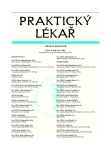Urologic care of patients after spinal cord injury
Authors:
V. Šámal
Authors‘ workplace:
Urologické oddělení
; Primář: MUDr. Jan Mečl
; Krajská nemocnice Liberec, a. s.
Published in:
Prakt. Lék. 2010; 90(4): 206-211
Category:
Reviews
Overview
This up-to-date review summarizes the current position concerning epidemiology, diagnostic procedures and therapy of lower urinary tract dysfunction following spinal cord injury. This article gives a list of stages of spinal cord injury from the urological point of view and explains diagnostic principles. The emphasis of this article is on the systematic review of therapeutic possibilities including modern procedures and recommendations for follow-up observation.
Key words:
spinal cord injury, dysfunction of the lower urinary tract, clean intermittent catheterization, sexuality.
Sources
1. National Spinal Cord Injury Statistical Centre. Facts and figures at a glance [online]. Updated April 2009. Dostupné na https://www.nscisc.uab. edu/public_content/facts_figures_2009.aspx.
2. Wyndaele, J.J. Complications of intermittent catheterization: their prevention and treatment. Spinal Cord. 2002, 40(10), p. 536-541.
3. Lindehall, B., Abrahamsson, K., Jodal, U. et al. Complications of clean intermittent catheterization in young females with myelomeningocele: 10 to 19 years follow-up. J. Urol. 2007, 178(3 Pt 1), p. 1053-1055.
4. De Ridder, D.J., Everaert, L., García Fernandéz, L. et al. Intermittent catheterization with hydrophilic-coated catheters (SpeediCath®) reduces the risk of clinical urinary tract injection in spinal cord injured patients: A prospective randomised parallel comparative trial. Eur. Urol. 2005, 48, p. 991-995.
5. Barendrecht, M.M., Oelke, M., Laguna, M.P., Michel, M.C. Is the use of parasympathomimetics for treating an underactive urinary bladder evidence-based ? BJU Int. 2007, 99(4), p. 749-752.
6. Yamanishi, T., Yasuda, K., Kamai, T. et al. Combination of cholinergic drug and an alpha-blocker is more effective than monotherapy for the treatment of voiding difficulty in patients with underactive detrusor. Int. J. Urol. 2004, 11(2), p. 88-96.
7. Patel, A., Patterson, J., Chapple, C. Botulinum Toxin injections for neurogenic and idiopathic detrusor overactivity: A critical analysis of results. Eur. Urol. 2006, 50, p. 684-710.
8. Krhut, J., Kopecký, J., Hradílek, P. a kol. Využití léčby neurogenních dysfunkcí dolních cest močových aplikací botulinumtoxinu do detruzoru. Čes. Urol. 2007, 11(3), s. 154-158.
9. Dykstra, D., Sidi, A., Scott, A. et al. Effects of botulinum-A toxin on detrusor sphincter dyssynergia in spinal cord injury patients. J. Urol. 1988, 139, p. 919-922.
10. Krhut, J., Mainer, K. Roční zkušenosti s využitím aferentní neurostimulace v léčbě hyperaktivního měchýře a syndromu pánevní bolesti. Praktická gynekologie 2001, 3, s. 44-48
11. Doležel, J., Čejpek, P., Miklánek, D. Sakrální deaferentace a neurostimulace předních kořenů míšních v léčbě neuropatického močového měchýře u pacientů s kompletní míšní lézí – první klinické zkušenosti. Rozhl. Chir. 2002, 81, s. 203-209.
12. Krhut, J. Neurourologie. Praha: Galén, 2005; 44-46. ISBN 80-7262-360-5.
13. Whitmore, W.F. III., Fam, B.A., Yalla, S.V. Experience with anteromedian (12 o´clock) external urethral sphincterotomy in 100 male subjects with neuropathic bladder. Br. J. Urol. 1978, 50(2), p. 99-101.
14. Seoane-Rodríguez, S., Sánchez, R., Losada, J., Montono-Marqués, A. et al. Long-term follow-up study of intraurethral stents in spinal cord injured patients with detrusor-sphincter dyssynergia. Spinal Cord. 2007, 45(9), p. 621-626.
15. Elliott, D.S., Barrett, D.M. Mayo Clinic long-term analysis of the functional durability of the AMS 800 artificial urinary sphincter: a review of 323 cases. J. Urol. 1998, 159(4), p. 1206-1208.
16. Venn, S., Greenwell, T.J., Mundy, A.R. The long-term outcome of arteficial sphincter. J. Urol. 2000, 164, p. 702-706.
17. Nomura, S., Ishido, T., Tanaka, K., Komiya, A. Augmentation ileocystoplasty in patients with neurogenic bladder due to spinal cord injury or spina bifida. Spinal Cord. 2002, 40, p. 30-33.
18. Gough, D.C. Enterocystoplasty. BJU Int. 2001, 88(7), p. 739-743.
19. Stohrer, M., Castro-Diaz, D., Chartier-Kastler, E. et al. European Association of Urology. Guidelines on neurogenic lower urinary tract dysfunction [on line]. Update March 2008. Dostupné na www.uroweb.org/fileadmin/user_upload/Guidelines/neurogenic.pdf.
20. Kenny, P.J., Lloyd, L.K., Lambert, M.C. Spinal cord injury information network. Ultrasound for urinary tract surveillance of person with SCI [on line]. Dostupné na http://www.spinalcord. uab.edu/show.asp?durki=21554.
21. Šrámková, T., Sutorý, M. Treatment of male erectile dysfunction following spinal cord injuries using PDE5 inhibitors. Rozhl. Chir. 2008, 87(5), p. 250-254.
22. Soler, J.M., Previnaire, J.G., Denys, P., Chartier-Kastler, E. Phosphodiesterase inhibitors in the treatment of erectile dysfunction in spinal-cord injured men. Spinal Cord. 2007, 45(2), p. 169-173.
23. Šrámková, T. Poranění míchy pohledem sexuologa. Praha: Svaz paraplegiků-Centrum informací a pomoci Paraple, 1997; s. 37-40.
Labels
General practitioner for children and adolescents General practitioner for adultsArticle was published in
General Practitioner

2010 Issue 4
Most read in this issue
- Myocarditis
- Subcutaneous traumatic rupture of the tibialis anterior tendon
- Occurrence of polycystic ovary syndrome and hyperadrogenemia in women with type 1 diabetes mellitus
- Heart failure with preserved systolic function of the left ventricle
